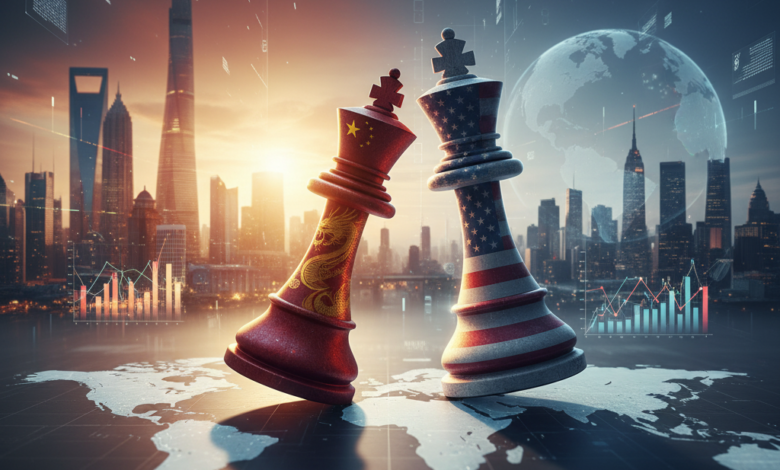China’s Rise: A Challenge to America’s Global Leadership

Introduction: Understanding the Geopolitical Landscape
The current geopolitical landscape is characterized by a significant shift in power dynamics, particularly with China’s ascent as a formidable global power. In recent decades, China has experienced unprecedented economic growth, transforming itself into a key player in international affairs. This rise has not only enhanced China’s influence but also prompted a reevaluation of established power structures, prominently including the United States. Historically, the U.S. has maintained a dominant position in global politics, economics, and military capabilities. However, as China continues to expand its reach, particularly in trade, technology, and military strength, it increasingly challenges America’s long-standing supremacy.
At the forefront of this transformation are several critical factors driving the geopolitical shift. Firstly, China’s Belt and Road Initiative (BRI) exemplifies its ambition to connect countries through infrastructure development, fostering economic ties that extend beyond its borders. This initiative has enabled China to invest heavily in developing countries, cultivating relationships that enhance its global standing. Furthermore, China’s focus on technological innovation, particularly in sectors like artificial intelligence and 5G, positions it as a leader in the digital economy, further complicating America’s efforts to maintain its technological edge.
Moreover, military modernization in China has reshaped the region’s security dynamics. The development of advanced military capabilities has enabled China to assert its influence in contentious areas such as the South China Sea. This assertiveness challenges America’s traditional role as the guarantor of security in the Asia-Pacific region. As a result, the United States must navigate this evolving landscape, balancing its responses to China’s actions while addressing the concerns of its allies and partners who are equally affected by this changing situation.
The Economic Powerhouse: China’s Growth Trajectory
Over the past few decades, China has transformed into a formidable economic powerhouse, characterized by unprecedented growth rates that have positioned it as a key player on the global stage. This remarkable trajectory can be traced back to several critical milestones that have fundamentally reshaped its economy. One of the foremost drivers of China’s economic ascent has been its focus on manufacturing. The nation has effectively positioned itself as the “world’s factory,” leveraging its vast labor force to produce goods at competitive prices. This concentration on manufacturing not only bolstered China’s GDP but also facilitated its integration into global supply chains.
Another pivotal factor contributing to China’s economic growth is substantial investment in technology. The country has made significant strides in developing high-tech industries and innovation. China’s government has implemented various policies aimed at promoting research and development, resulting in increased productivity and the emergence of homegrown technological giants. By prioritizing sectors such as artificial intelligence, telecommunications, and renewable energy, China has not only enhanced its economic capabilities but also generated a competitive edge over other nations, including the United States.
Furthermore, China’s strategic approach to global trade has played an integral role in its economic expansion. The country’s “Belt and Road Initiative” exemplifies its commitment to expanding international trade networks, establishing infrastructure projects that enhance connectivity across several regions. By fostering economic partnerships with various countries, China has been able to secure markets for its goods while simultaneously diminishing the economic influence of the U.S. and its allies. This multifaceted strategy underscores the systemic changes occurring in the global economic landscape, presenting a direct challenge to America’s long-standing position as the preeminent global economic leader.
Military Modernization: A New Era of Defense
In recent years, China’s military modernization has evolved into a critical component of its national strategy, reshaping the dynamics of global military power. This comprehensive transformation encompasses advancements in technology, strategic planning, and an expanding military presence that significantly enhances China’s defense capabilities. As a result, China’s military modernization represents a formidable challenge to U.S. military strength, particularly in the Asia-Pacific region.
At the heart of this modernization effort is China’s commitment to developing advanced technologies. The People’s Liberation Army (PLA) has invested heavily in artificial intelligence, cyber warfare, and next-generation weaponry. This includes innovations such as hypersonic missiles, advanced aircraft, and precision-guided munitions, which enable China to execute complex military operations with unprecedented efficiency. These advancements not only bolster China’s defensive posture but also enhance its offensive capabilities, allowing it to project power beyond its borders.
Strategically, the modernization of China’s military is accompanied by a shift in doctrine, focusing on asymmetric warfare and regional security. By prioritizing these elements, China aims to counterbalance the established military dominance of the United States, particularly in contested areas like the South China Sea. The evolving naval capabilities, including the expansion of the Chinese navy and the development of aircraft carriers, signify a commitment to securing maritime interests and asserting territorial claims.
Moreover, China’s global military presence is expanding, with increased participation in international exercises and a growing network of overseas bases. This enhanced operational reach significantly impacts the U.S. influence in the region, compelling American defense planners to reassess their strategies. As China’s military modernization continues to advance, the implications for U.S. global leadership are profound, raising concerns about the balance of power in the Asia-Pacific and beyond.
The Belt and Road Initiative: Expanding Influence
The Belt and Road Initiative (BRI) is an ambitious infrastructure and economic development project initiated by China in 2013. Aiming to bolster trade and stimulate economic growth across Asia, Europe, and Africa, the BRI seeks to create a modern Silk Road through a network of railways, highways, and maritime routes. This extensive initiative is aimed at enhancing connectivity between countries and facilitating smoother trade, thus expanding China’s economic influence on a global scale.
Through investments in infrastructure projects, such as roads, bridges, ports, and energy facilities, China is strategically positioning itself as a pivotal player in international trade and finance. The BRI has already seen participation from numerous countries, many of which are developing nations that are in dire need of economic revitalization. By providing funds and expertise, China is not only aiding these nations but also establishing itself as an indispensable partner in their development. This expanding network of partnerships reflects a conscious effort to engage nations in ways that may challenge traditional U.S. alliances and influence.
The implications of the Belt and Road Initiative are profound. While it offers an opportunity for growth and infrastructure development in recipient countries, it also raises concerns about debt dependency and transparency. Many critics argue that the strategy could result in countries becoming beholden to China, thus shifting the balance of power in international relations. This growing web of influence is, therefore, viewed by some as a direct challenge to the U.S.’s historical role as a dominant global leader, as it promotes a new framework for collaboration and power dynamics across the globe.
Tech Rivalry: The Battle for Innovation
The technological landscape has become a critical arena of competition between China and the United States, often defining the contours of global leadership. In this context, the race for innovation emphasizes advancements in key sectors, particularly artificial intelligence (AI), telecommunications, and cybersecurity. As both nations vie for supremacy, their innovations and strategies could have profound implications for international relations and economic stability.
Artificial intelligence is at the forefront of this rivalry. China’s investment in AI research and development has skyrocketed over the past decade, driven by governmental support and a vast pool of data generated from its large population. The Chinese government has articulated a clear ambition to become a world leader in AI by 2030. This focus poses a significant challenge to American tech giants, which have historically led the AI field. Such advancements not only enhance China’s technological capabilities but also create competitive pressures on U.S. companies to accelerate their innovation efforts.
In the area of telecommunications, China’s Huawei has emerged as a global leader, showcasing advanced 5G solutions. The rapid deployment of 5G technology is crucial as it provides the backbone for various technologies, including the Internet of Things (IoT) and autonomous vehicles. The U.S. has responded with its initiatives to bolster homegrown technologies while expressing concerns over national security implications tied to reliance on foreign telecommunications infrastructure.
Cybersecurity has also become an essential component of the rivalry. As both nations increasingly depend on digital infrastructure, maintaining robust cybersecurity measures is paramount. The United States remains vigilant regarding potential espionage and cyberattacks attributed to Chinese actors, further complicating the geopolitical landscape. This ongoing battle for superior technological capabilities signifies a shifting dynamic that may redefine America’s position as a global leader in innovation.
Soft Power: China’s Cultural and Diplomatic Strategies
China has increasingly recognized the importance of soft power as a crucial aspect of its strategy to enhance its global standing. By leveraging cultural diplomacy, media influence, and international partnerships, China seeks to reshape the narratives that dominate the global discourse, presenting itself as a leader on various fronts while subtly countering American influence.
Cultural diplomacy plays a significant role in China’s soft power strategy. Initiatives such as the Confucius Institutes, which promote Chinese language and culture worldwide, act as platforms for fostering educational exchanges and enhancing mutual understanding. Through art exhibitions, film festivals, and cultural exchanges, China aims to create a favorable image that highlights its rich cultural heritage and progressive values, distinguishing itself from other powers.
Media influence is another pivotal component of China’s approach. State-sponsored media outlets, such as CGTN, seek to provide alternative narratives to those presented by Western media. By expanding its global reach through strategic partnerships, China strives to ensure that its perspective is represented in international discussions, thereby challenging the dominance of American media narratives. Moreover, the rise of digital platforms has allowed Chinese content to permeate global audiences more effectively, further reinforcing its soft power.
International partnerships, often characterized by economic investments, play a significant role in China’s soft power strategy. Initiatives like the Belt and Road Initiative expand China’s influence by building infrastructure and fostering economic ties with countries across Asia, Africa, and Europe. These partnerships are not merely transactional; they are often presented as opportunities for mutual growth, enhancing China’s role as a benevolent global leader. Through these multifaceted strategies, China is actively reshaping the global narrative, positioning itself as a formidable challenger to America’s traditional dominance.
Geopolitical Tensions: Areas of Conflict and Cooperation
The relationship between the United States and China has been characterized by a complex interplay of conflict and cooperation. The trade disputes between the two nations have emerged as one of the most significant sources of tension, particularly in recent years. Tariffs imposed on goods have not only affected economic growth but have also led to retaliatory measures that further exacerbate the situation. These trade tensions reveal underlying competitive dynamics that raise questions about future economic collaboration.
Another area of contention lies in the territorial claims in the South China Sea. Chine’s assertive stance over disputed islands has prompted the U.S. to conduct freedom-of-navigation operations, which are intended to ensure international maritime laws are upheld. Such actions have led to confrontations that underscore the strategic rivalry between the two powers. The implications of these maritime disputes extend beyond regional stability, as they symbolize the broader geopolitical struggle for influence in Asia-Pacific.
Human rights issues continue to fuel tensions as well. Allegations regarding China’s treatment of ethnic minorities, particularly in Xinjiang and Tibet, have drawn criticism from the U.S. government and human rights organizations. The U.S. has utilized diplomacy and sanctions as tools to address these concerns, representing a fundamental clash of values that complicates bilateral relations. Nevertheless, it is essential to explore potential avenues for cooperation amid these challenges. Joint efforts in areas such as climate change, global health, and non-proliferation can provide platforms for dialogue and collaboration, enabling both nations to confront shared challenges while avoiding unilateral antagonism.
As the U.S. navigates these multifaceted tensions, a balanced approach that recognizes the complexities of U.S.-China relations is vital. Such a strategy will not only facilitate constructive dialogue but also help maintain America’s leadership role on the global stage, ensuring that competition does not diminish the possibilities for cooperative engagements.
Responses to the Challenge: U.S. Policy Implications
The rise of China presents significant challenges to the global leadership traditionally held by the United States. To address these challenges effectively, the U.S. must adopt a multifaceted strategic approach that includes strengthening alliances, increasing defense spending, and investing in innovation. Each of these responses plays a critical role in countering China’s growing influence on the world stage.
Strengthening alliances is essential for the U.S. to maintain a robust position globally. Collaborative efforts with key allies such as Japan, Australia, and nations in Europe can create a unified front that enhances collective security and economic resilience. Initiatives like the Quadrilateral Security Dialogue (Quad) aim to foster cooperation between these countries, primarily to counterbalance China’s military assertiveness in the Indo-Pacific region. By reinforcing existing alliances and creating new partnerships, the United States can effectively respond to the geopolitical shifts attributed to China’s ascendancy.
Another vital response involves increasing defense spending. The U.S. military must adapt to the evolving nature of global threats posed by China. This includes investing in advanced technologies, such as artificial intelligence and cyber warfare capabilities, which are critical in modern warfare. Enhanced military readiness, coupled with a commitment to modernize defense systems, will ensure the U.S. remains competitive and capable of deterring potential aggressions by China.
Lastly, investing in innovation is paramount for sustaining U.S. leadership. The technological race between the U.S. and China highlights the need for significant investments in research and development. By fostering innovation in critical sectors like technology, renewable energy, and infrastructure, the U.S. can not only bolster its economic standing but also counter China’s attempts to dominate these fields. Strengthening both public and private sector cooperation will play a key role in sustaining U.S. competitiveness against China’s rise.
Conclusion: The Future of U.S.-China Relations
The rise of China as a global power presents a complex challenge to America’s long-standing leadership position. As China continues to enhance its economic, military, and technological capabilities, the dynamics of U.S.-China relations are likely to shift significantly. Understanding this evolving landscape is crucial for anticipating the implications for global stability and governance.
One possible scenario is greater cooperation between the United States and China. Both nations face transnational issues such as climate change, public health crises, and global economic instability that require collaborative efforts. Engaging in dialogue and establishing frameworks for partnership on these shared challenges could lead to productive outcomes, fostering a more stable international environment.
Conversely, the tensions between the two powers may exacerbate, especially in areas such as trade, human rights, and regional security. The South China Sea and Taiwan remain flashpoints that could provoke conflict if mismanaged. In this scenario, the U.S. may reinforce its alliances in the Asia-Pacific region, potentially leading to an arms race or heightened military confrontations. This trajectory could pose significant risks not only to bilateral relations but also to global peace and economic development.
To navigate this intricate relationship, a nuanced approach is essential. Policymakers must balance competition and cooperation by recognizing the interdependence of the two nations. Engaging with China while simultaneously asserting U.S. interests requires deft diplomacy and strategic foresight. Through multilateral forums and strong alliances, the U.S. can work to mitigate conflicts and promote a rules-based international order that encourages mutual respect and cooperation.
In conclusion, the future of U.S.-China relations remains uncertain, shaped by an ongoing interplay of cooperative and competitive elements. The decisions made in the coming years will significantly impact both national interests and the global landscape.






















